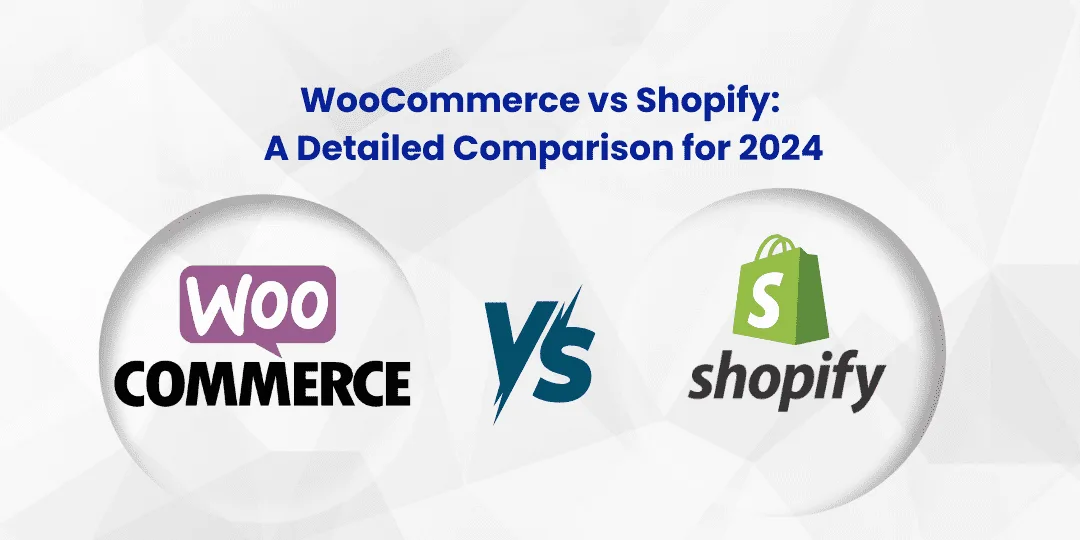WooCommerce vs Shopify: A Detailed Comparison for 2024
Choosing the right e-commerce platform is critical for the success of your online store. WooCommerce and Shopify are two of the biggest names in the e-commerce space, each offering distinct advantages depending on your business needs.
In 2024, both platforms have evolved, bringing new features, pricing models, and integrations that can impact your decision. This comprehensive guide will dive deep into every aspect of WooCommerce and Shopify, helping you decide which is better for your specific situation.
Overview of WooCommerce and Shopify
WooCommerce and Shopify are two leading platforms in the e-commerce space, each with its unique strengths suited to different types of users. Here’s a closer look at what each offers:
WooCommerce: The Customizable Plugin for WordPress
Core Architecture: WooCommerce is an open-source e-commerce plugin designed specifically for WordPress. It leverages WordPress’s powerful CMS capabilities, making it a formidable tool for users who already have a WordPress website or who are familiar with the WordPress ecosystem.
Customization and Flexibility: Being open-source, WooCommerce offers unparalleled customization opportunities. Users can access and modify the source code, tailor the functionality with custom plugins, and choose from a vast array of themes. This flexibility allows shop owners to create a highly personalised shopping experience that can be fine-tuned to meet specific business requirements.
Integration and Extensions: WooCommerce seamlessly integrates with the broader WordPress environment, which includes thousands of plugins and themes that can enhance functionality or alter aesthetics. Whether it’s SEO tools, payment gateways, or marketing extensions, WooCommerce’s adaptability is a significant advantage for users looking to expand or customise their e-commerce capabilities.
Shopify: The All-in-One E-commerce Platform
Core Architecture: Shopify is a hosted e-commerce platform that provides businesses with an all-in-one solution to build, manage, and scale their online stores. Unlike WooCommerce, Shopify is not tied to any content management system and operates independently, providing users with a dedicated e-commerce suite.
Ease of Use and Support: Shopify is renowned for its user-friendliness. The platform offers a streamlined setup process, intuitive management tools, and comprehensive support, making it an ideal choice for entrepreneurs who prefer a more straightforward approach to online store management. The simplicity of Shopify makes it accessible even to those without any technical skills.
Built-in Features and Scalability: Shopify excels in providing a robust set of built-in features, including various sales channels, integrated payment solutions (Shopify Payments), inventory management, and more. The platform is designed to be scalable, handling everything from small startups to large enterprises with ease. Shopify’s managed hosting environment ensures high performance and security as businesses grow.
Cost Comparison
When choosing an e-commerce platform, cost is often a decisive factor. Here’s how WooCommerce and Shopify stack up in terms of expenses:
Initial Setup
- Shopify has a straightforward cost structure with three main plans:
- Basic Shopify: $29/month
- Shopify: $79/month
- Advanced Shopify: $299/month Each plan comes with domain registration, web hosting, SSL certificate, and access to Shopify’s secure payment gateway.
- WooCommerce is free to install as a WordPress plugin. However, you need to consider the costs for:
- Web hosting: Starts at $5/month (shared hosting) to $100/month (dedicated hosting).
- Domain name: Typically around $10-15/year.
- SSL certificate: Can be free (Let’s Encrypt) or up to $70/year for premium options.
Recurring Expenses
- Shopify charges a monthly fee plus transaction fees (if not using Shopify Payments) and credit card fees, which vary by plan.
- WooCommerce has no monthly fees. However, you’ll pay for web hosting, domain renewal, and potentially for additional plugins and themes to extend your store’s functionality.
Add-ons and Extensions
- Shopify offers a robust app store with thousands of apps. Most have a monthly fee, which can add up quickly if you need lots of functionality beyond the basics.
- WooCommerce also has thousands of plugins. Many are free, but premium plugins can range from $25 to $300 (one-time or annual fees).
Ease of Use: Shopify vs. WooCommerce
When choosing an e-commerce platform, one of the key considerations is the ease of use. Both Shopify and WooCommerce offer unique user experiences that cater to different types of users. Here’s a more in-depth look at how each platform meets the needs of its users, focusing on setup, day-to-day management, and customization capabilities.
Shopify: Designed for Simplicity
Setup Process: Shopify shines in its simplicity and user-friendliness. The platform is a hosted solution, which means that Shopify takes care of all the hosting requirements. Users can start setting up their online store right after signing up. The process is straightforward: you choose a theme, customize it, add products, and you’re ready to sell. Shopify provides a step-by-step wizard that guides new users through this process, making it accessible even for those without any technical background.
Interface: Shopify’s admin interface is clean and intuitive. Everything is logically organized, which makes managing the day-to-day operations of an online store quite straightforward. From adding products and managing inventory to fulfilling orders and setting up taxes, each aspect of the store management is designed to be user-friendly.
Theme Customization: Shopify offers a range of professionally designed themes, which can be customised using a visual editor. This drag-and-drop interface allows you to adjust elements like fonts, colours, and layouts without touching a line of code. For more advanced customizations, Shopify does provide access to the HTML and CSS of your store, but this requires some coding knowledge.
Support and Resources: Shopify provides 24/7 customer support through multiple channels, including phone, email, and live chat. Additionally, there’s a vast array of resources such as guides, tutorials, and forums available to help users understand how to make the most out of their Shopify store.
WooCommerce: Flexible but Complex
Setup Process: Unlike Shopify, WooCommerce is not a hosted platform, which means you need to handle the hosting yourself. This involves choosing a hosting provider, installing WordPress, adding the WooCommerce plugin, and then setting up the store. While this process offers more control over the store, it definitely requires more technical skills and a steeper learning curve.
Interface: WooCommerce leverages the WordPress user interface, which is familiar to those who have used WordPress before but can be overwhelming for newcomers. The WooCommerce plugin integrates seamlessly with the WordPress dashboard, adding multiple new options like orders, products, coupons, and reports. Managing a WooCommerce store feels much like managing a WordPress site, which means it has a less specialized user interface compared to Shopify.
Theme Customization: The flexibility of WooCommerce comes into play with themes. There are thousands of WordPress themes available, many of which are optimized for WooCommerce. While many themes offer customization options through the WordPress Customizer, which provides some level of drag-and-drop functionality, getting your site to look exactly how you want it often requires custom CSS or PHP coding.
Support and Resources: WooCommerce support is community-driven, with extensive documentation, forums, and a large developer community available for troubleshooting. Unlike Shopify, direct support from WooCommerce can be limited unless you purchase premium themes or plugins, which often offer dedicated support.
Customizability
WooCommerce: WooCommerce provides exceptional customization potential due to its open-source nature, making it an excellent choice for those who require specific modifications or features that are not available out-of-the-box. Users can access and modify the source code, allowing for deep customizations that can tailor almost every aspect of the e-commerce experience. Additionally, the extensive plugin ecosystem surrounding WordPress and WooCommerce means that you can easily add new features without needing to develop them from scratch.
- Themes and Design: WooCommerce users can choose from thousands of themes, many of which are specifically optimised for WooCommerce. Moreover, since WooCommerce is built on WordPress, users have access to a wide range of WordPress themes that offer full compatibility with WooCommerce.
- Plugin Integration: The WordPress repository includes over 55,000 plugins, many of which integrate seamlessly with WooCommerce. This allows store owners to add complex functionalities like bookings, subscriptions, and memberships easily.
- Developer Community: The large developer community for WooCommerce means that it is continually being improved and that support is readily available from fellow users and professional developers alike.
Shopify: Shopify offers a more controlled customization environment, which is less daunting for beginners and ensures that store configurations are more standardised and less prone to errors. However, this comes at the cost of flexibility.
- Theme Customization: Shopify provides its users with a range of professionally designed themes. While these themes are customizable through a drag-and-drop interface and allow for adjustments in color schemes, layouts, and fonts, the changes you can make are not as extensive as those in WooCommerce unless you dive into Liquid, Shopify’s proprietary templating language.
- App Marketplace: Shopify’s App Store is extensive, offering over 6,000 apps that can extend the functionality of your store. While this is beneficial, many of these apps come with a monthly fee, which can add up quickly.
- Custom Development: For deeper customization, users often need to hire Shopify experts familiar with Liquid, which can increase the cost of operating a Shopify store significantly.
Scalability
Shopify: Shopify is renowned for its ability to scale effortlessly. Being a hosted platform, Shopify takes care of all backend upgrades, security enhancements, and infrastructure scalability.
- Managed Hosting: Shopify’s hosting is optimized for performance and scalability, capable of handling sudden spikes in traffic and sales volume without any input from the store owner.
- Plan Upgrades: Shopify’s tiered pricing plans allow businesses to scale operations smoothly. Each upgrade not only supports greater volumes of sales and products but also introduces advanced features like professional reports and third-party calculated shipping rates.
WooCommerce: WooCommerce’s scalability is heavily dependent on the hosting environment chosen by the store owner. While it offers great flexibility, it requires more oversight.
- Hosting Requirements: To scale a WooCommerce store, you might need to upgrade to high-performance specialized WooCommerce hosting solutions, manage caching, and maintain security updates.
- Custom Scalability: Unlike Shopify, scaling a WooCommerce site can be highly customized. You can choose what aspects of your hosting environment to upgrade (such as adjusting CPU resources, RAM, or storage), and you can integrate with enterprise-level services as needed.
Support
Shopify: Shopify’s support structure is comprehensive, offering 24/7 access via phone, email, or live chat. This is complemented by a vast array of documentation, tutorial videos, and an active community forum. For businesses that do not have an in-house technical team, this level of support can be invaluable.
WooCommerce: Support for WooCommerce is primarily community-driven. While there is extensive documentation available, direct support typically comes from your hosting provider or third-party plugins. For users who need dedicated help, hiring a developer or consultant familiar with WooCommerce and WordPress is often necessary.
Both WooCommerce and Shopify offer robust e-commerce solutions but cater to different user needs and skill levels. WooCommerce provides unparalleled flexibility and customization at the cost of higher complexity and potential maintenance challenges. Shopify offers ease of use, stability, and excellent support, making it ideal for those who prefer a more straightforward, less hands-on approach.
Payment Gateways and Additional Fees
When setting up an online store, understanding the nuances of payment gateways and the fees associated with them is crucial for managing costs and providing seamless customer transactions.
Shopify Payment Gateways and Fees: Shopify offers its proprietary payment solution, Shopify Payments, which is streamlined and integrated directly within the Shopify platform. Using Shopify Payments simplifies the payment process and offers several advantages:
- No Transaction Fees: Shopify waives transaction fees if you use Shopify Payments. This can result in substantial savings, especially as your sales volume grows.
- Integrated Experience: Handling everything from payments to refunds within Shopify’s dashboard creates a seamless management experience.
- Additional Fees for External Gateways: If you opt for external payment gateways like PayPal, Stripe, or others, Shopify charges an additional fee on each transaction. These fees range from 0.5% to 2% depending on your Shopify plan. This can add up and is something to consider if you have a preferred payment processor that is not Shopify Payments.
WooCommerce Payment Gateways and Fees: WooCommerce provides flexibility in choosing payment gateways, as it seamlessly integrates with a multitude of payment options through plugins. This open approach allows store owners to select the best gateways based on their specific needs, geographic location, and fee structures.
- No Additional Fees from WooCommerce: WooCommerce itself does not charge any additional transaction fees. However, each payment gateway or processor will have its own set of fees, which are not controlled by WooCommerce.
- Broad Compatibility: WooCommerce can integrate with virtually any payment service, including major ones like PayPal, Stripe, and Authorize.net, as well as region-specific options that may be vital for reaching wider markets.
SEO Capabilities
SEO is a critical component for any e-commerce store, affecting visibility, user engagement, and ultimately sales. Both platforms offer robust SEO capabilities but in slightly different ways.
WooCommerce SEO: WooCommerce benefits greatly from its foundation on WordPress, which is renowned for its SEO strengths. This integration allows WooCommerce sites to leverage the powerful SEO tools available for WordPress.
- Full Control Over SEO: Users have complete control over aspects like meta tags, URL structures, and even the finer details of XML sitemaps. This level of control can significantly enhance your ability to optimize your site for search engines.
- Plugins for Enhanced SEO: Plugins like Yoast SEO, All in One SEO Pack, and others integrate seamlessly with WooCommerce, offering advanced features that can further optimize your site. These plugins help automate many aspects of SEO, from content analysis to technical optimizations.
Shopify SEO: Shopify also offers strong SEO capabilities, which are designed to work well within the confines of its hosted platform.
- Built-in SEO Features: Shopify comes with essential SEO features like customizable headlines, titles, and meta tags. It also automatically generates sitemaps, making it easier for search engines to crawl and index your site.
- Less Control, Easier Management: While Shopify doesn’t offer as much control over SEO as WooCommerce, it manages many aspects automatically, which can be beneficial for users who prefer a more hands-off approach. However, for advanced SEO, you might need to rely on third-party apps, which can sometimes limit the extent of customization.
Conclusion
The choice between WooCommerce and Shopify in 2024 depends largely on your specific business needs, technical ability, and budget. You can always look for service providers who are dedicated consultants for business owners with tight budgets. For instance, Code B has been helping its clients to build a user-friendly website at decent pricing . Perfect for any small business owners looking for outsourcing/offshoring their web development needs from any part of the world. Outsourcing any software development from countries like India Pakistan is preferably cheaper.
If you need a cost-effective, highly customizable platform and are comfortable with technical management , WooCommerce is an excellent choice. If you prefer an easier, all-in-one solution with less technical hassle, Shopify is likely the better option.
Both platforms are capable of powering successful online stores, so your decision should align with your long-term business goals and how much you’re willing to invest in time or money to get your ideal store up and running.





